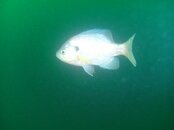soltari675
Contributor
I've been practicing quite a bit with my camera. I even have some pictures posted in the gallery here. But I have a frequent problem that I am not sure if it is solved by camera settings, technique, or both and was hoping to get some insight from other photographers. I know the idea is to get as close as you can to your subject, however I find that doing so causes me to get too bright a flash on the subject. Here is an example:

This picture was taken with the flash set as low as possible. I use a sealife dc1000 camera and a sealife strobe. Sometimes, I can get decent pictures. Is it the angle of the strobe that can mean the difference between a good picture and a washed out one? Is there a setting on the camera that can help? Thank you for the advice in advance!

This picture was taken with the flash set as low as possible. I use a sealife dc1000 camera and a sealife strobe. Sometimes, I can get decent pictures. Is it the angle of the strobe that can mean the difference between a good picture and a washed out one? Is there a setting on the camera that can help? Thank you for the advice in advance!







